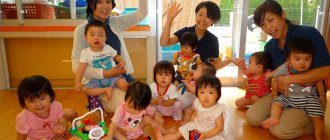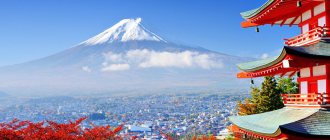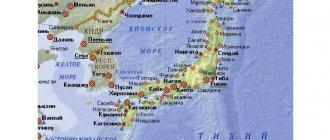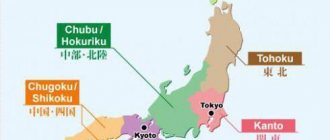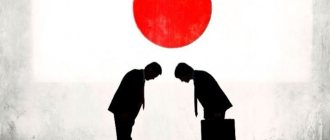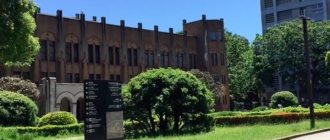School in Japan is divided into three levels:
- Primary School (Grades 1-6) - Shogakko
- Middle school (grades 7-9) - chugakko
- High School (grades 10-12) - Kotogakko
The numbering of classes is not continuous, as in Russia, but internal - “first grade of elementary school,” “second grade of high school,” and so on. Parallels are usually indicated by letters of the Latin alphabet: 1-A (first parallel of the first class), 1-B (second parallel of the first class) and so on, or by numbers: 1-1, 1-2 and so on.
Primary and secondary schools in Japan are compulsory for everyone and free of charge. High school is not compulsory, but about 95% percent continue their studies after high school. 48% of high school graduates go on to college (2 years) or university (4 years).
Tuition in high school and university is always paid, but in public institutions it is cheaper. There are also fee-paying private primary and secondary schools. In all paid institutions you can study for free or get a big discount if you win a scholarship competition.
Japanese mothers tend to be very attentive to their children's success. They maintain close contact with teachers, participate in the life of the school, and in case of illness of children, sometimes even go to classes instead of them and take notes on lectures. Such fanatical mothers are called “kiyoiku mama.”
At the same time, the children themselves often “sit on the neck” of their parents until they are about 25-30 years old, when they begin to earn enough to feed themselves.
Japanese education system
As in most countries, education in Japan is divided into preschool, school and higher education. After graduating from university, you can continue your studies - enroll in graduate school and then doctoral studies. However, it is worth considering that in Japan, with a population of 127 million, there are only 2.8 million students, which is almost three times less than, for example, in Russia, where the population is 20 million more. Therefore, enrolling in a Japanese university requires enormous efforts and, of course, financial costs.
In order to “settle” in life in the future, children are accustomed to constant mental and physical labor from elementary school. Starting in the 4th grade (upon reaching the age of 10), schoolchildren in Japan take exams, since students are not automatically promoted from class to class. Therefore, in order to successfully move up the school “career” ladder, children try to regularly attend additional education centers - the so-called juku. Many schoolchildren and students are also undergoing distance learning.
Preschool education: nursery and kindergarten
Preschool education in Japan is not compulsory until the age of three. Kindergartens, mostly private, are divided into so-called authorized ones, which meet the highest educational standards, and unsanctioned ones. In the first, oddly enough, tuition fees are lower, since they are actively supported by the state and local authorities, so the queues are huge.
Depending on the age of the child, preschool institutions are divided into two types: hoikuen (nursery) - for children from 10 months to three years old and yochien (kindergarten) - for children from three to six years old. To send a child to hoikuen, parents must submit documents indicating that they cannot study with the child at home. This could be a certificate from the place of work or confirmation of a serious illness of the father or mother.
Yochien is a mandatory stage in a child’s education, which is why some kindergartens are created at schools and even universities.
Japanese children are “decided” on their future profession from an early age. Therefore, if potential migrants are interested, for example, in teaching children to draw in Japan, they should try to enroll their child in an elite kindergarten with a creative program. To enroll in such a yochien, children will have to pass mini-exams, and parents will have to generously pay for tuition (a regular kindergarten will cost $100-300, and an elite one will cost $1,500 per month, not counting fees for excursions).
School education
The school education system in Japan involves dividing the learning process into three stages. This division is common for immigrants from the CIS countries. Japanese children from 6-7 to 17-18 years old must attend three “schools”:
- primary;
- average;
- senior (formally attendance is not required, but after high school only 6% of students leave).
The general education program is designed for 12 years. How many grades in school a student has to complete depends on his own decision. For example, if a teenager decides not to enroll in high school and continue his studies in college, he only needs to complete 9 grades (that is, study 6 years in elementary school and 3 years in high school). Therefore, it is not difficult to calculate at what age Japanese schoolchildren graduate from school: if they completed 12 grades, then at 17 or 18 years old. Those students who went to local colleges or schools will already receive a diploma by age 18.
Speaking about how schools are organized in Japan, it should be noted that the school year here is divided into trimesters and begins on April 1, which is difficult for migrants to get used to. Another “strange thing”: every year the child’s classmates and teachers change. The Japanese believe that constant “shuffling” within groups helps schoolchildren to socialize and better find a common language with new people. But the holidays will not be something unusual for residents of the CIS - children here rest in winter, spring and, most of all, in summer, and study from Monday to Friday (in some schools, including Saturday).
Junior or primary school in Japan
Primary, or junior school, introduces children to basic disciplines. The list of required subjects for all subjects is as follows:
- Japanese language;
- calligraphy;
- mathematics;
- music;
- World Art;
- physical training;
- LIFE SAFETY FUNDAMENTALS;
- work.
Children with disabilities can receive inclusive education in primary school, that is, master the program together with physically healthy students. If desired, parents can send their special child to a specialized institution. In such educational institutions, schoolchildren can study anything - from secular ethics to the general theory of health.
The cost of such training will be approximately the same as in any private school - about $3,500 per year, not counting the entrance fee (up to $1,800) and expenses for excursions and textbooks.
High school in Japan
Secondary school - from 7th to 9th grade - is available to those who have successfully passed the final exams. This does not mean that a student who fails to score the minimum required number of points will be expelled from school after the 7th or 8th grade - in most cases, he will simply have to change his educational institution to a less prestigious one. This means that you will have to adapt to the new program, which each school in Japan chooses independently.
In high school, new humanities and sciences are added to study, as well as mastering a musical instrument. It is no coincidence that many children at this time begin to be interested in music school; Yamaha schools are especially popular. Local tutors train not only musicians, but also actors, however, it is expensive - about $53 for one lesson in a prestigious institution.
Also in secondary school, work with gifted children begins in earnest. For children 13-15 years old, there are many hobby groups or clubs (bukatsu), the cost of classes on average is $30 per month. Most popular destinations:
- sports (especially martial arts and baseball);
- programming;
- movie;
- photo;
- ikebana (the art of arranging bouquets).
High school in Japan
Speaking about the age at which people enter high school in Japan, let us remember: this happens mainly at the age of 14-15. By this time, schoolchildren have time to pass several exams, make friends in interest clubs and, of course, decide on their future profession. Based on the list of favorite subjects, teenagers will have to choose a specialization - the humanities or natural sciences, as well as additional subjects that will be needed to study for admission to university. Such disciplines may be:
- economics (in-depth study);
- agronomy;
- medicine;
- foreign language.
As already noted, about 6% of Japanese go to college after graduating from high school. The professions that can be obtained in these educational institutions are well known to residents of the CIS: hairdresser, cook, electrician, etc. The average cost of college is $7,000 per year, and the most expensive is to study to become a culinary specialist.
Average
Any child can receive a secondary education; there are no exams after the sixth grade. Education in Japan divides the middle stage of education into stages:
- Full;
- Incomplete.
Children who are Japanese citizens are required to complete junior high school education. free in government institutions .
You have to pay to get a complete secondary education. Japanese people have the choice of attending senior high school or attending college. As part of this stage, students are required to wear uniform. Education in Japan even regulates the color of socks: blue, black or white.
In secondary school, subjects included in the elementary curriculum continue to be taught. Hours are devoted to studying the history of Japan, physics, chemistry, and music. The Japanese say that the most difficult subjects are Japanese with English , and mathematics . Each semester of intermediate level education ends with a comprehensive exam that includes the entire list of subjects. Periodically, schoolchildren take tests in languages and mathematics. Duration of training is 3 years, Japanese graduate at 15 years old .
Numerous exams - preparation for final exams to move on to the next stage.
School at the Russian Embassy in Japan
Russian-speaking migrants from the CIS countries, who fear that their children will not cope with the increased workload in a Japanese school, may be interested in how the Russian school at the embassy in Japan works. There is an opinion that only children of embassy workers can be admitted to this institution, but this is not entirely true. This school can be accessed by appointment. However, the cost of training here is quite high, but renting housing will cost even more. Since the school is located in a prestigious area of Tokyo, you can rent an apartment here for no less than $1,300 per month.
There is another way for a Russian-speaking child to receive an education in Japan: exchange education for schoolchildren is available to residents of the CIS. Teenagers aged 15-18 years can take part in such programs. The duration of the program is 12 months, the cost of participation is $9,100. The school at the Russian Embassy is also involved in organizing training and finding families for accommodation.
Organization of studies
Unlike Russian schools, in Japan each class is assigned its own classroom (in Russia, the classroom is assigned to the teacher). Therefore, it is not the students, but the teachers who walk from office to office between lessons. The office assigned to the class is signed with the appropriate sign.
There are different teachers for each grade and each subject, although in small schools this may not be the case. Japanese schools often do not have cafeterias or locker rooms, so students have to eat lunch and hang their clothes in the classrooms. At the end of lessons, students themselves completely clean the school and school grounds. There are no cleaners in Japanese schools.
Joint field trips and excursions to ancient Japanese cities and temples are often organized for schoolchildren. Such excursions usually last up to three to four days.
For most middle and high schools, school uniforms are required. Each school has its own, but in reality there are not many options. Usually this is a white shirt and dark jacket and trousers for boys and a white shirt and dark jacket and skirt for girls, or sailor fuku - “sailor suit”. Primary schoolchildren, as a rule, dress in ordinary children's clothing.
Getting higher education
With 94% of students planning to attend college, it appears that compulsory higher education exists in Japan. This is not actually true, but it is very close to the truth. There are a huge number of universities in the country - 728, and the competition in the most prestigious of them is prohibitive - from 20 to 200 people per place.
Education in Japan for foreigners is available on a competitive basis. In addition, a potential student must take preparatory courses in order to receive a qualifying diploma of knowledge of the Japanese language. The document must be certified by the All Japan Teachers Association and approved by the Ministry of Education.
However, it is worth going abroad for courses not only to “pull up” your language, but also to learn the specifics of studying at universities in Japan. The fact is that there are no mandatory lectures or seminars to attend - the student only has to earn 125-150 so-called credit units, and passing one test or exam is equivalent to 1-2 units. Thus, during 4-6 years of study, a student must choose subjects that interest him and master them. Cheating on exams is strictly prohibited - for this, the student will lose all credits and be expelled from the university, and the money spent will not be reimbursed.
Education for migrants from the CIS
Most universities teach in Japanese. So if you are interested, for example, in training for Kazakhstanis, you should not expect that abroad you will be able to speak your native language. Japan is an extremely closed country, and there are very few people from the CIS there (no more than 40,000 people in the entire country).
Studying for Ukrainians in Japan involves the following algorithm: first you improve your language, complete preparatory courses, and only then apply to a university. These rules are relevant for both future bachelors and graduate students.
Defense of a diploma/dissertation in any European language is permitted in exceptional cases.
However, in some cases it is still possible to get an education in Japan in English. This mainly happens in branches of US universities located in Japan (for example, Sophia University). In addition, at some universities you can take an entrance interview in English, but the training will be in Japanese.
Academy
In addition to regular public schools, there are also private fee-paying academies (gakuen), as well as “national” schools - schools of national importance. To enter them, you need to pass special exams in conditions of great competition. On the other hand, they have better educational programs, and many of them provide non-competitive admission to high school or university.
Typically, the children of the Japanese elite study at academy schools: politicians, businessmen, diplomats, and professors from famous universities. Those who receive scholarships to study at academies often turn out to be “black sheep” and sometimes become the subject of bullying by classmates. Some academies do not require wearing a school uniform.
How to enter a Japanese university
The first thing you need to do before enrolling is to save up a sufficient amount of money, since it will not be possible to recoup the costs of training while working and studying at the same time. There are very few options for going to study in Japan for free: no more than 200 people a year win grants for budget places, and there are over 2.8 million students here (and only local ones, i.e. Japanese citizens).
In addition, as already mentioned, you need to take preparatory courses lasting at least two semesters, preferably in Japan itself, and then start preparing documents.
Try to immediately decide whether you intend to continue your studies in a master’s program, since there are practically no opportunities to move from one university to another after admission. Also, get proof that you have completed at least 12 years of education in your home country (for CIS residents this is usually school plus the first year of university), and feel free to submit your documents!
If you are over 18 years old and have no problems with obtaining a visa (criminal records, dangerous diseases, etc.), you will be allowed to take exams common to all foreigners, namely:
- general education exam in the humanities or natural sciences;
- Japanese language test;
- entrance internal exams;
- interview.
Applying for a study visa
A student visa to Japan is issued at the embassy or visa center if you have an invitation from at least one Japanese university. Also, to obtain a visa you need another important piece of paper - the so-called certificate from the Ministry of Justice of Japan. This document is required for anyone who plans to stay in the country for a period of more than 90 days, since it contains information about the status of the visitor (in this case, that the migrant is a student at a language school or university).
Documents for admission
To qualify for an invitation from a guarantor, you need to send documents in advance to the admissions committee of a language school or university. Do not forget that the school year in Japan begins on April 1, and if documents are sent by regular mail and not by email, you need to allow another 20-30 days for delivery. The package includes the following papers:
- statement;
- autobiographical sketch;
- school certificate;
- a college diploma or transcript from the first year of university (for those who need to “gain” 12 years of education);
- a recommendation from a teacher who taught the applicant Japanese;
- certificate of absence of dangerous diseases (HIV/AIDS, tuberculosis);
- photographs (requirements vary by institution);
- a copy of a foreign passport;
- sponsorship letter and/or bank statement.
Prestigious universities, especially medical universities, may require additional documents from applicants. So, if some lectures at the institute are given in English, TOEFL and/or IELTS certificates will be required. Details about the conditions for admission should be found on the official websites of the universities you are interested in.
Japanese visa extension
Student visas are renewed either every 6 months or once a year - usually in March-April, since this is when the academic year begins. Both visitors studying at language schools (but not more than two years in a row) and students of universities and colleges can apply for renewal. If a person has entered the university, but is not yet very confident in speaking Japanese, he can continue attending a language school in parallel with his main studies. The same practice applies to those who decide to continue their studies in graduate school and obtain a scientific degree.
Are you interested in master's programs for Russians, Ukrainians and people from other CIS countries? Then you will have to pass a language proficiency exam, an exam for admission to a university, graduate from a Japanese university or confirm a diploma received at home, study for six months or a year, renew your visa - and calmly continue to study further for 6 years (this is exactly the period of study in a master's program in Japan), periodically extending permission to stay in the country.
List of main universities
As already mentioned, there are a huge number of universities in Japan. At the same time, the most popular educational institutions are those included in international rankings, such as QS and USNews. If you want to study at the best university in Japan and are willing to pass all tests with a 95% rate, it makes sense to apply to the universities listed in the table below.
| University name | Official site | general information |
| Tokyo University | https://www.u-tokyo.ac.jp/ | In world rankings, the faculties of the University of Tokyo are second only to American and English ones; The most prestigious professions are lawyer and philologist. 30,000 students, including 2,100 foreign students. Alumni include Nobel Prize winners in literature and Japanese prime ministers. |
| Teikyo University (Tokyo) | https://www.teikyo-u.ac.jp/ | The university was founded in 1966 and is currently recruiting for 10 faculties and 30 areas of special training. The University has a School of Medicine. It has its own research center and student financial support programs. |
| Osaka University | https://www.osaka-u.ac.jp/ | One of the largest universities in Japan. Like other universities in Osaka, it is a very prestigious institution. 11 faculties, 12,000 students, 8,000 graduate students, including 1,500 foreign ones. A library containing over 2.2 million scientific publications and textbooks. Branches in the USA, the Netherlands and Thailand. |
| Nagoya University | https://www.nagoya-university.uz/ | International University: many visiting students, mainly from China, Korea, Vietnam, Uzbekistan. Preparing for a career in international companies. 9 faculties, the opportunity to study as a teacher, engineer, or agricultural specialist. |
Japanese language schools
As already noted, you can apply to a university only after studying preparatory courses (at least two semesters). To do this, some applicants use distance learning programs, but in most cases, future students study in Japan itself. In this case, when applying for a visa, the administrator of the language school becomes the guarantor issuing the invitation. There are similar educational institutions in all major cities of Japan:
- Tokyo;
- Fukuoka;
- Kobe;
- Sapporo;
- Yokohama.
These schools provide an opportunity to meet fellow foreigners who want to learn Japanese and enlist the support of teachers (almost all teachers speak English). Tuition costs start from $2,000 per semester.
Cost of education in Japan
The cost of education in Japan is one of the biggest obstacles to obtaining it. State universities that train highly qualified specialists (for example, doctors) charge students about $31,200 for six years of study. But studying at a private university will cost almost 20 times more – about $268,100. Therefore, local students rarely fail exams. Parents usually pay for education, and children cannot afford to cause such damage to the family budget.
However, how much it costs to study in Japan is not the main obstacle. Don’t forget about indirect costs that you won’t be able to cover even by winning a scholarship or grant. An international student, in particular, will have to fork out for:
- room in a hostel (up to $40 per month);
- for renting an apartment (up to $1,300 per month) – if there are no places in the hostel;
- food, hygiene items (up to $715 per month);
- travel tickets;
- textbooks, notebooks and other materials for study and work.
Grants and scholarships for foreigners
Successful students from the CIS countries can receive scholarships and grants to study in Japan. True, only 20% of future bachelors manage to take advantage of such programs - they receive up to $360 per month. Graduate students can earn more - up to $800 per month, but even this amount will not cover half of the costs of training, including indirect ones.
True, pleasant bonuses for successful students are not always expressed in monetary terms. Many colleges and universities offer guaranteed employment for graduates in Japan. Considering that in the state it is customary to get a job once and for all by concluding a lifelong contract, this is a very valuable bonus.
Uniform
Primary school students are exempt from wearing special uniform clothing. They are allowed to wear theirs. Some primary education institutions have uniforms. For boys - a white shirt, short shorts and a cap. Pants can only be put on when moving to medium. Girls wear long gray skirts and white blouses.
Backpacks are of particular importance for schoolchildren, their prices can vary from about 7000 yen to 70-80 thousand (about 58-650 euros), they can use one backpack for a very long time. One of my friends had a child go to first grade, and to her joy, the school itself purchased backpacks for the children - in the end the backpack cost only 8,000 yen. This is for the better, because when everyone has the same thing, you don’t want to get what your neighbor has.
But the other girl was less fortunate, their school was elite and a kind and wealthy granny decided to please her granddaughter by buying a very expensive backpack for 74 thousand yen! Crazy price for a small child, in my opinion. Although, this is already decided by the parents. So. In secondary and higher schools, uniforms are a mandatory attribute. The guys wear formal suits, similar to military uniforms, dark in color, and a white shirt. Girls - dark knee-length skirts, sometimes sundresses, light blouses, sailor suits, knee-length socks and flat shoes. The length of the skirts is fixed, but many girls roll them up to make them shorter - yes, we had this too :)).
Each school tries to come up with its own unique clothes so that they differ in color or details. And it made her stand out from the rest. Japanese students are required to have a change of shoes, and each student has their own locker. First of all, the children run to him to put away their street shoes.
Pros and cons of studying in Japan
Each phenomenon has its own advantages and disadvantages. To sum it up, we can say that studying in Japan is very tempting. Despite all the difficulties, the applicant cannot but rejoice that:
- Japan has the highest quality of education - it was in this country that many Nobel laureates studied, mainly in chemistry and physics;
- a Japanese diploma will open the doors of almost any large international company to the graduate;
- e-learning in Japan is accessible even to people with disabilities;
- Japanese authorities annually allocate about $130 billion for scientific research, so initiatives will not go unnoticed.
However, for those who are not ready for physical and emotional overload, studying in Japan will be very difficult. In addition, as mentioned above, obtaining an education requires significant financial expenses. Therefore, you should only move to Japan and enroll in a university if you want to join a family already living in this country or plan to build a career in major companies.
Exams
Exams in Japan are traditionally the biggest challenge for students. Each exam lasts for several hours, and their complexity necessitates preparation for them over a long period. Very difficult exams (both in Japan and other Asian countries - for example, South Korea) are a common cause of student suicide.
There are no exams in primary school, but in middle and high school exams are taken five times a year - at the end of terms and in the middle of the first two terms. The midterm exams cover mathematics, Japanese and English, social studies and science. At the end of each trimester, large comprehensive exams are taken that test absolutely all subjects.
The exam results determine whether a student will advance from middle school to high school. Depending on the scores received, schools are determined - for those who showed high results, prestigious educational institutions are offered, for students with poor results, bad schools are offered, after which they cannot enter universities. As a rule, graduates of such schools have no career prospects.
Immigration for students
Do you want to get an education at a Japanese university and thus gain a foothold in the country? This is difficult to do, but possible. To obtain permanent residence and eventually apply for citizenship, it is advisable to start looking for work while still a student. But remember: according to Japanese law, a person enrolled in a university has the right to work no more than four hours a day.
However, combining study and work in Japan is very difficult. So there is another way: after receiving a diploma or winning a certificate, you can immediately get a job as an intern at any company. It will be better if you are already a highly qualified specialist and have work experience.

